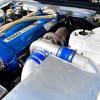Nytsky's Engine Build
Announcements
-
Similar Content
-
Latest Posts
-
By BuiltNotBought · Posted
Yes that’s what im trying to decide. Should I do stock gtt box or enclosed or open pod. -
Also, I note OP is in Melbourne, which begs the question... are you aware of how illegal your car will be with a turbo, and intercooler and any sort of filter change? I don't know how you can get past the "2 intake mods" "rule" that seems to exist in Vic. Fully engineered might or might not get you there.
-
If you have a turbo... then the ducting holes I used to feed the pod are not available because your intercooler likely uses them. If you have an intercooler, your IAT's are going to be goverened by how good your intercooler setup is. I'm yet to really see anyone check IAT with a snorkel/boxed pod/proper CAI versus and unshielded pod. It would be interesting! But I suspect that the differences would not be so noticeable as if you were N/A as the intercooler is where the air is being cooled.. and out in front where the FMIC would be is a pretty good spot for it.. When I was turbo I pushed the stock GTT box as far as I could and made some pretty good power out of it, and noticed on the street I never made the same power/boost. Then I did a before and after run with a pod filter versus the box and picked up about 9PSI from the same boost duty cycle and about 50KW instantly. I never ran the stock box again, and recently removed it for my N/A setup. The box is restrictive to a degree - Even with the V8 setup I noticed I picked up power by removing the box completely, so punching holes from the bottom of it to get air from the passenger guard *helps* but the most effective one in my case was simply having the ducts, a pod, and no box around it. In my experience, *more* air was better than cold air. The air (with ducts) will be cooled off as you start moving, and especially if you start moving fast (a race track). It actually moves around quite a bit as you can see.
-
Well you could certainly buy or build an enclosure for a pod in that corner of the bay. It is absolutely vital that there is a nice big opening to let cold air in to it from the front or underside, otherwise it will just pull air in around the edges from the bay, and if that air is hot, you gain nothing from enclosing the pod. There is lots of good evidence around (including on here, see posts by @Kinkstaah for example) showing that pods pulling hot air from the bay is only a problem when you're static or slow in traffic, and that as soon as you get the car up and moving the air being grabbed by the pod cools down. Although that will obviously vary from car to car, whether there is a flow of cold air to the pod or if it all has to come through the radiator area, etc etc. Obviously, the whole exercise requires as much thought as anything else does. Doing the lazy thing will often end up being the dumb thing. The stock GTT airbox has a cold air snorkel to feed it from over the radiator. Shows that Nissan were thinking. The GT airbox is upside down compared to the turbo one, yeah? Inlet at the bottom, AFM/exit on the lid? That might make it harder to route the turbo inlet pipe using the GT airbox than a turbo one. That would probably be the main reason I'd consider not using it, not that it is too small and restrictive. I'm looking at a photo of one now and the inlet opening seems nice and large. Also seems to have the same type of snorkel that the turbo one has. Maybe all that's required is to make a less restrictive snorkel/cold air inlet, perhaps by punching down through the guard like I did.
-






Recommended Posts
Create an account or sign in to comment
You need to be a member in order to leave a comment
Create an account
Sign up for a new account in our community. It's easy!
Register a new accountSign in
Already have an account? Sign in here.
Sign In Now